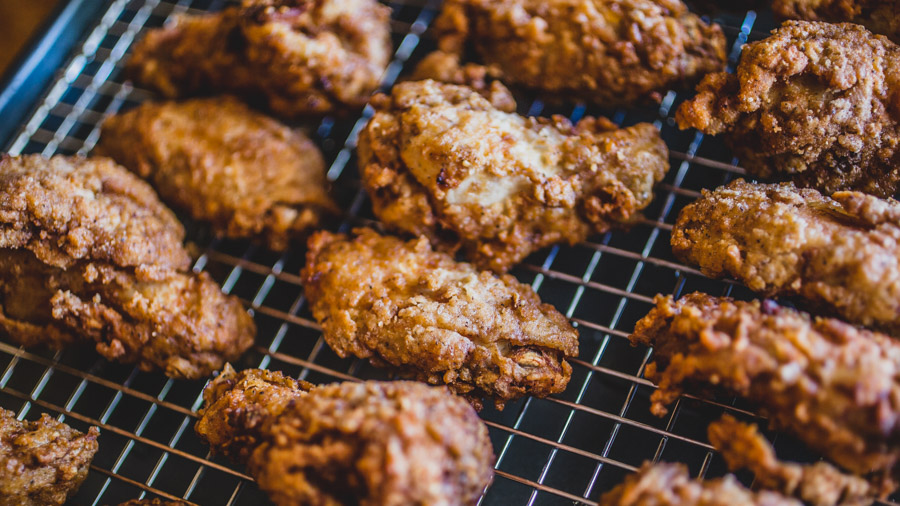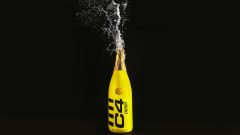How To CRUSH Making Fried Chicken At Home

Experiencing fried chicken, when done properly, is like scoring the winning basket against a rival team in an ’80s coming-of-age film without your teen wolf powers. As Amy Holland put it: You’re shooting for the moon and finally make it.
I’ve tried making fried chicken several times at home, and each time it was just enough to fill my cravings. Never once, however, did it blow me away. So what had I been doing wrong?

Because I firmly believe making proper fried chicken is something I’ll need to know before I can venture into my 30’s, I sought out every juicy nugget of wisdom I could find.
This includes as many tips and tidbits from friends, professionals, and the Internet, that I possibly get my hands on.
If you’re ever looking to fry up a batch of chicken at home, perhaps you’ll want to stick to these fried chicken tips.
Fry in small batches

The number one thing to know about cooking fried chicken, according to chef Josh Elkin, is to fry in small batches.
“The more crowded the pot or fryer, the less even the chicken will fry and the longer it will take,” Elkin told Foodbeast.
“Making fried chicken is a bitch,” he adds, “But it’s fried chicken, so that’s the payoff.”
It’s all about the temperature
Never deep-fry cold chicken. When you’re about to cook, let your raw chicken sit out for a least 30 minutes until it gets to room temperature. The reason is that cold chicken will affect the cooking oil and dramatically lower the temperature once the pieces are thrown in.
This also causes the oil to soak into the skin — creating soggy, greasy chicken. Chef Linh Nguyen of Fleenor’s on 4th recommends a temperature around 335F.
Chicken skin is essential
According to simplifried, frying chicken pieces at a high temperature lets you know that there is no more fat sitting between the meat and the skin once it’s golden brown.
Because the fat works to fry the skin, removing the skin directs the fat towards the meat when cooking in high temperatures. This results in greasy chicken. Keeping the skin on acts as a barrier.
If you choose not to eat the skin, that’s up to you. If you’re doing fried chicken, though, it’s at least half the joy behind it.
Cooking oil is also essential

Put those fancy-flavored oils away. You’re going to need a fat with a high smoke point and a neutral taste. Canola oil, peanut oil, vegetable oil, or even lard are all ideal. Avoid extra-virgin olive oil at all costs.
Don’t be afraid to brine

A well-seasoned buttermilk brine makes a world of difference for fried chicken. While salt and pepper are essential you can also add some paprika, cayenne pepper, or hot sauce to give that chicken some heat.
Letting your meat brine overnight, or at least 8 hours, yields some fantastic results.
Take a fork and… what??
Celebrity chef Gordon Ramsay once shared with Foodbeast that you need to puncture the chicken to the bone with a fork before brining it. This way, the buttermilk seeps all the way into chicken and tenderizes the meat.
Season the flour

You’ve seasoned your brine, but don’t forget to also season your flour.
Again, you’ll need at least salt and pepper. After that you can be creative with the spices you use.
“Buttermilk brine and cornstarch mixed with the batter to make it super crunchy,” says Chef Aron Habiger of Cooking on the Lam.
It’s OK to double dip

Once you have your chicken coated in seasoned flour, you’re good to go right? Sure, but if you want that extra crispy skin, you can also let that chicken sit for a few minutes on a wire rack so that any excess liquid absorbs. Then, dip it into your seasoned flour a second time before frying.
The result: crispy, crunchy chicken.
Wire rack > Paper towels
We’ve often heard that laying down some paper towels will absorb the excess oils of the chicken. However, the steam created from the moist paper towels will then lead to soggy fried chicken. Instead, lay your fried chicken pieces on a wire rack so the excess oil falls off.

The Spyrou Finisher
Former recipe blogger and gatekeeper of dad jokes, Constantine Spyrou, had this little technique to share if you’re ever worried about burning your chicken.
“The longer the chicken sits in the frying oil, the more can get inside,” he said. “I like to get it to the right color on each side and then finish it off in the oven.”
He says he runs the oven to 350-degrees for both the oil and oven, so the chicken spends about 5 minutes in the oil and the rest of the cooking time in the oven —10 or so minutes.
“It keeps the chicken moist, keeps it from overcoloring, and prevents too much oil from breaking into the meat and making it greasy.”
The leftover cooking oil?

Your fried chicken is cooked, you’ve eaten your fill, and now it’s time to clean up. After finishing those dishes, your oil has now probably cooled a bit. I can’t stress this enough: NEVER dump your used cooking oil into the sink.
If you’re looking for ways to dispose of the oil, here are some options.






















